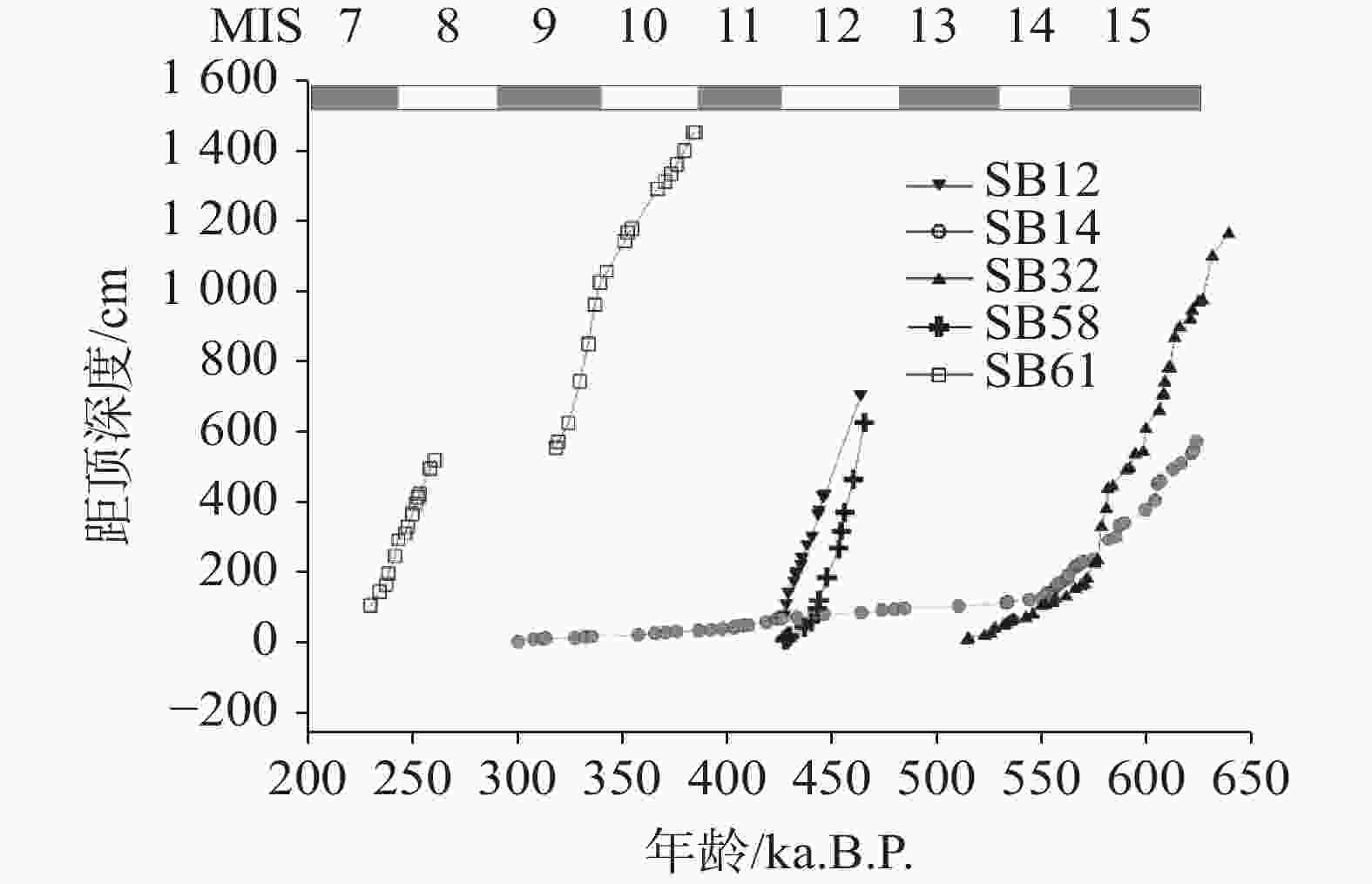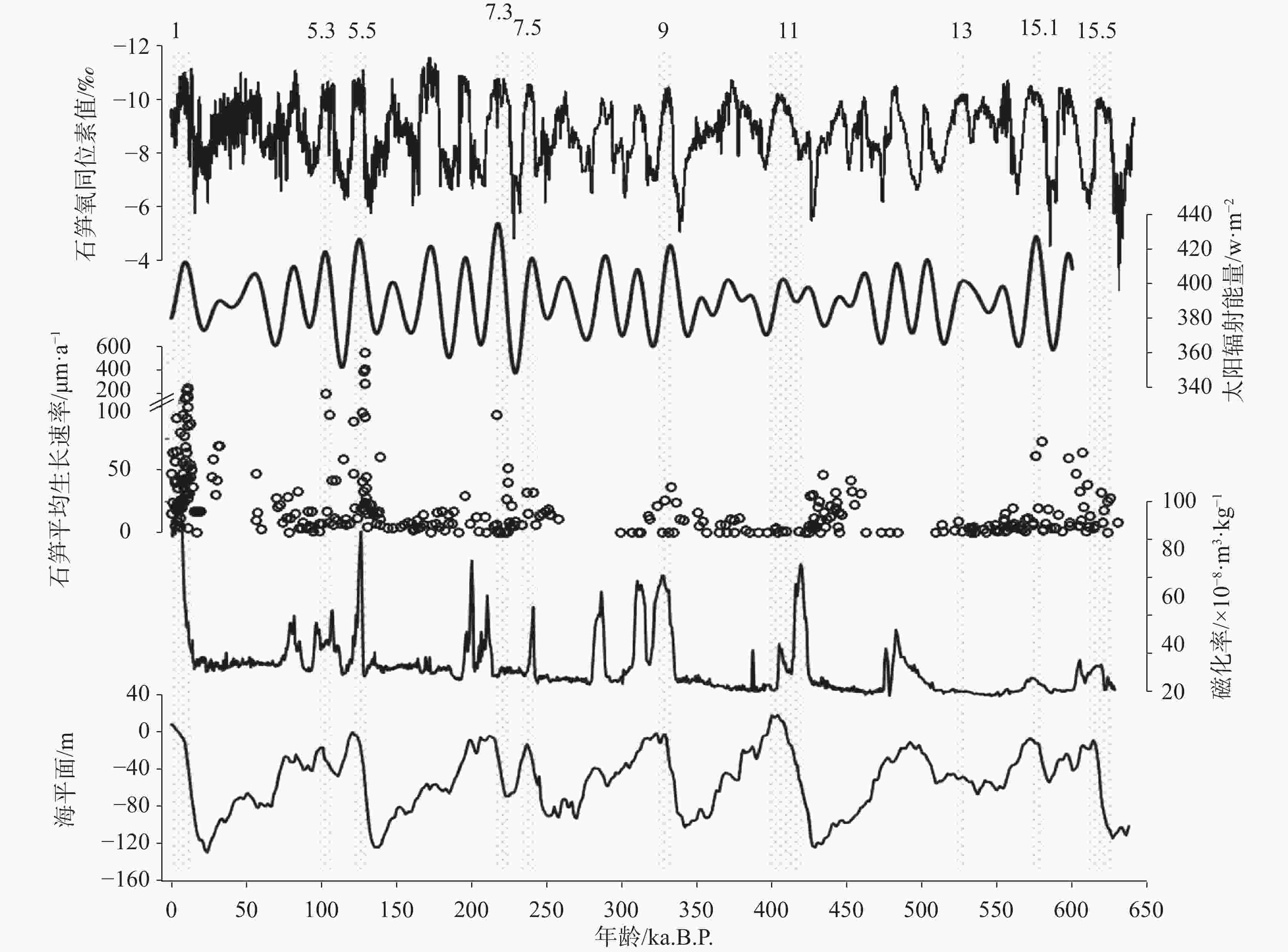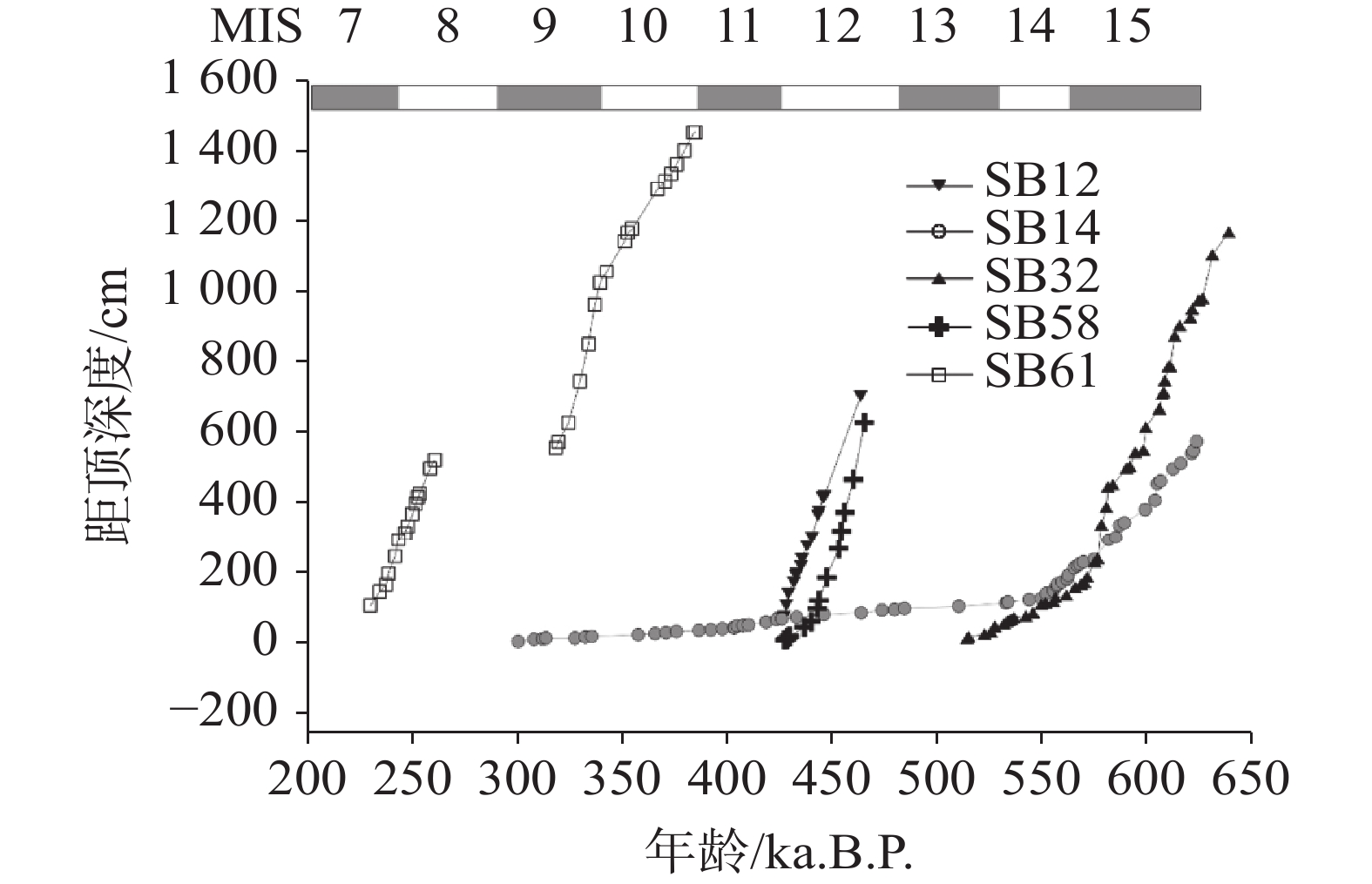Variation of stalagmite growth rate and its paleoclimatic significance in Sanbao cave, Hubei Province over the past 640,000 years
-
摘要: 利用石笋平均生长速率变化来重建古气候环境变迁已成为洞穴古气候研究的重要领域。文章以湖北三宝洞横跨22~64 万年的5支石笋167个230Th年龄数据为材料,结合过去的工作,重建了晚更新世64万年以来长江中下游地区东亚夏季风降水变化过程。结果表明:深海氧同位素(MIS)1,5.3, 5.5, 7.3,7.5,9,15.1,15.5阶段石笋生长速率显著增大,指示东亚夏季风强度增强,降水增多;相反,冰期阶段生长速率缓慢或者不发育,指示夏季风强度减弱,降水明显减少,但平均生长速率指标并不能定量指示夏季风强度变化。当石笋生长速率低于10 µm·a−1时,不能有效地指示冰期—间冰期旋回变化。在轨道尺度上,平均生长速率所揭示的冰期—间冰期波动可能归因于全球冰量和太阳辐射共同作用的结果。Abstract:
In the past few decades, great progress has been made in the study of stalagmite paleoclimate. Compared with the geochemical indicators such as stalagmite δ18O, the average growth rate of stalagmite is a physical indicator, which can directly reflect the wet and dry changes of the external climate, and is one of the important means to reconstruct the past regional hydrological changes. Sanbao cave (31°40′N, 110°27′E), the study area, is located in Shennongjia National Nature Reserve, Hubei Province, on the north bank of the Three Gorges of the Yangtze River and adjacent to the southern edge of the Loess Plateau. Mainly affected by the East Asian summer monsoon, the average annual temperature in this area is 8-9℃ with the annual precipitation of 2,000 mm. In summer, warm and humid air from the equatorial ocean enters the hinterland of the mainland, bringing about 60% of the annual precipitation. In winter, the dry and cold air from Siberia controls the climate in Shennongjia area, so it is particularly sensitive to the seasonal advance and retreat of East Asian summer monsoon. Sanbao cave, 1,900 m above sea level, is located on the northern slope of Shennongjia Mountain in Hubei Province, covered with limestone layer about 300 m thick. The thickness of the surface layer is about 2-3 m, mainly distributed with trees, shrubs and weeds. The research objects are five stalagmites (numbered SB12, SB14, SB32, SB58 and SB61) from Sanbao Cave, with a cumulative height of about 2.991 m, of which SB61 was deposited in 229.4-384 ka B.P., corresponding to MIS8-MIS10; SB14 grew and developed from 299.6-622.8 ka B.P., spanning from MIS9 to MIS15; SB12 and SB58 were respectively deposited at 425.1-462.7 ka B.P. and 426.7-464.7 ka B.P., corresponding to MIS12; SB32 grew from 514.3-638.2 ka B.P., and spanned from MIS13 to MIS15. 167 230Th age data of these five stalagmites was obtained by the analytical instruments of Thermo-Finnigan Element and Thermo-Finnigan Neptune in Minnesota Isotope Laboratory, the USA. The age analysis error was ±2σ measurement statistical error with the error accuracy of 0.5-2.0 ka. For the calculation of average growth rates of stalagmites, firstly, the data of stalagmite age reversal in stratigraphy has been excluded. Then, the curve of the measured age point of stalagmite and its corresponding growth depth has been established. The new results are basically consistent with the growth rate curve in the original literature. Finally, the average growth rates of stalagmites have been obtained by dividing the depth difference between two adjacent points by the measured age difference. Based on 167 230Th age data from 5 stalagmites spanning 220,000 to 640,000 years in Sanbao cave, and combined with the past work, this paper has reconstructed the precipitation change process of East Asian summer monsoon (EASM) in the middle and lower reaches of the Yangtze River over the past 640,000 years in the late Pleistocene. The results show that the growth rates of stalagmites in Marine Isotope Stages (MIS) 1, 5.3, 5.5, 7.3, 7.5, 9, 15.1, 15.5 increased significantly, indicating that the intensity of EASM increased significantly with more precipitation in the interglacial stage. On the contrary, the slow or undeveloped growth rates in the glacial stage indicate the weakening of the summer monsoon intensity with less precipitation. Based on statistical analysis of the growth rates of 22 stalagmites, we hold that the average growth rate index cannot quantitatively indicate the change of the monsoon intensity. Moreover, when the stalagmite growth rate is less than 10 µm·a−1, it also cannot effectively indicate the glacial-interglacial change. On the orbital scale, the glacial-interglacial fluctuation revealed by the average growth rate may be attributed to the joint action of global ice and solar radiation. Finally, it should be noted that in different time scales, the controlling factors of stalagmite growth rate are complicated, and the noise generated by the environment difference inside the cave may cover up or weaken the transmission of the climate signal from the outside to the inside. Therefore, the possible influencing factors must be carefully considered when we reconstruct the paleoenvironment by using the average growth rates of stalagmites. -
Key words:
- stalagmite /
- growth rate /
- glacial-interglacial period /
- East Asian summer monsoon /
- Sanbao cave /
- Hubei
-
图 3 湖北三宝洞石笋氧同位记录[10-11]、北半球夏季太阳辐射(b)[12]、平均生长速率(c)、靖远黄土磁化率记录,其高值表示东亚夏季风强度增强,低值表示东亚夏季风强度减弱(d)[13]与海平面记录(e)[14]的综合对比(从上至下),图中数字代表深海氧同位素阶段
Figure 3. Comparison among stalagmite δ18O record (a)[10-11], insolation in July at 65°N (b)[12] , the average growth rate in Hubei Sanbao cave (c), loess magnetic susceptiblility record from Jingyuan, Gansu (d)[13] and sea level (e)[14]
表 1 三宝洞5支石笋年龄—深度数据*
Table 1. Age-depth data of 5 stalagmites in Sanbao cave
样号 深度
/mm年龄
/ka B.P.年龄误差
/ka样号 深度
/mm年龄
/ka B.P.年龄误差
/ka样号 深度
/mm年龄
/ka B.P.年龄误差
/kaSB-12 65 425.1 1.1 209.5 564.3 5.9 870 612.3 5.5 71 426.2 1.1 215.5 566.0 4.7 901 614.6 5.2 104 427.3 0.9 220.5 566.9 3.9 922 619.9 5.7 136 428.4 1.2 226.5 568.9 4.9 948 620.7 5.6 168 431.1 1.3 234.5 573.9 4.6 972 623.7 5.7 187 432.0 1.0 290.5 580.9 4.8 977 623.9 6.5 194 432.3 1.2 298.5 584.2 5.8 977 625.6 9.9 215 434.4 1.5 332.5 586.0 4.5 1 105 630.3 6.8 234 434.8 1.1 340.5 588.3 5.4 1 170 638.2 7.4 272 437.1 1.5 378.5 598.3 6.2 SB-58 3 426.7 1.25 299 439.6 1.0 404.5 603.0 6.7 5 427.2 3.0 362 442.5 1.3 451.5 604.0 6.3 10 428.0 1.7 372.5 443.1 1.5 459.5 605.5 6.4 14 428.8 1.0 412 444.7 1.2 493.5 611.6 7.1 40 435.9 1.4 416 445.5 1.5 509.5 615.3 8.4 57 439.3 2.1 700 462.7 4.6 537.5 620.3 10.0 94 442.3 1.4 SB-14 0.3 299.6 3.0 545.5 621.2 6.2 116 443.0 1.2 6.2 307.3 3.4 572.5 622.8 6.4 182 446.5 1.3 8.5 311.3 1.0 SB-32 8 513.3 2.7 265 452.4 1.3 8.8 313.1 3.6 13 514.1 3.8 316 453.6 1.4 10.2 326.9 3.4 20 521.6 2.8 370 455.2 1.8 12.8 331.8 3.6 27 524.8 3.4 465 459.5 1.8 13.5 334.8 0.7 43 526.6 2.9 625 464.7 1.9 19.5 356.8 1.3 50 531.0 3.8 SB-61 102 229.4 0.7 22.0 364.8 2.9 56 532.7 3.2 141 233.7 1.0 25.5 370.0 0.9 59 533.4 3.3 161 236.9 0.2 28.5 375.1 2.9 62 534.5 3.0 193 237.9 0.3 31.5 385.6 1.2 68 535.7 3.1 243 241.1 0.2 33.5 391.5 2.7 72 541.5 3.1 291 242.6 0.3 35.5 396.9 2.8 82 544.8 4.1 311 245.7 0.3 38.5 402.3 3.5 105 548.7 4.6 330 247.1 0.3 39.5 402.6 2.3 110 550.7 4.0 366 249.5 0.3 44.0 403.9 3.9 114 554.6 4.3 394 251.1 0.5 45.0 406.8 5.0 125 555.6 3.8 413 252.1 0.2 47.5 409.5 6.0 131 560.8 4.3 423 252.8 0.2 55.0 417.8 2.1 153 564.8 3.9 495 257.8 0.4 62.0 422.6 2.0 163 567.7 3.7 519 260.0 0.3 64.0 425.3 4.4 168 569.2 4.4 553 317.7 0.7 69.0 432.3 2.1 183 570.6 3.6 571 319.0 0.8 76.0 445.2 1.8 227 574.3 3.4 623 323.7 0.6 81.5 462.9 3.3 236 575.7 3.8 742 329.2 0.8 88.5 473.0 2.4 334 577.3 4.7 847 333.2 1.0 91.0 478.9 7.8 384 579.8 4.0 960 336.3 0.7 94.5 483.7 4.5 442 580.6 4.0 1 023 338.9 0.6 99.5 509.5 7.3 449 582.8 4.5 1 055 341.8 1.0 109.0 531.8 6.2 495 589.3 5.0 1 143 350.4 0.9 112.5 532.9 7.0 501 590.9 4.2 1 167 351.9 1.0 118.5 542.9 5.6 541 593.6 5.1 1 178 354.0 0.8 122.5 548.7 4.3 547 597.4 5.0 1 291 366.0 1.0 136.5 551.0 4.4 612 598.5 5.4 1 313 369.5 1.0 143.5 554.3 4.2 665 605.1 5.6 1 334 372.6 1.2 157.5 556.0 4.2 705 606.3 5.2 1 361 375.0 0.9 162.5 556.3 4.5 712 607.0 4.5 1 400 378.8 1.1 168.5 558.8 3.5 744 607.5 5.1 1 450 383.1 1.3 177.5 561.0 3.8 784 609.4 6.6 1 452 384.2 1.4 187.5 561.5 5.4 785 610.1 8.9 注:*年龄数值来自文献[10]。
Note: *Age value is from literature[10]. -
[1] Fleitmann D, Burns S J, Neff U, Mudelsee M, Mangini A, Matter A. Palaeoclimatic interpretation of high-resolution oxygen isotope profiles derived from annually laminated speleothem from Southern Oman[J]. Quaternary Science Reviews, 2003, 23(7-8):935-945. [2] Kashiwaya K, Atkinson T, Smart P. Periodic variations in Late Pleistocene speleothem abundance in Britain[J]. Quaternary Research, 1991, 35(2):190-196. doi: 10.1016/0033-5894(91)90066-E [3] 邵晓华, 汪永进, 孔兴功, 吴江滢. 南京葫芦洞石笋生长速率及其气候意义讨论[J]. 地理科学, 2003, 23(3):304-309.SHAO Xiaohua, WANG Yongjin, KONG Xinggong, WU Jiangying. Approach to the growth rate and climatic significance of stalagmites in Hulu Cave, Nanjing[J]. Scientia Geographica Sinica, 2003, 23(3):304-309. [4] 林玉石, 张美良, 覃嘉铭, 朱晓燕,程海. 再论洞穴石笋的沉积速率[J]. 地质论评, 2005, 51(4):435-442. doi: 10.3321/j.issn:0371-5736.2005.04.011LIN Yushi, ZHANG Meiliang, QIN Jiaming, ZHU Xiaoyan, CHENG Hai. Growth rate of cave stalagmite[J]. Geological Review, 2005, 51(4):435-442. doi: 10.3321/j.issn:0371-5736.2005.04.011 [5] 杨琰, 袁道先, 程海, 覃嘉铭, 林玉石, 张美良, 朱晓燕. 贵州荔波董歌洞较老石笋ICP-MS 230Th测年研究及古气候应用[J]. 地层学杂志, 2008, 32(2):201-206.YANG Yan, YUANG Daoxian, CHENG Hai, QIN Jiaming, LIN Yushi, ZHANG Meiliang, ZHU Xiaoyan. Research on old stalagmites by ICP-MS 230Th dating and paleoclimate reconstruction in Dongge Cave, Libo, Guizhou[J]. Journal of Stratigraphy, 2008, 32(2):201-206. [6] 张美良, 朱晓燕, 李涛, 邹丽霞. 桂林现代洞穴碳酸盐:石笋的沉积速率及其环境意义[J]. 海洋地质与第四纪地质, 2011, 31(1):125-134.ZHANG Meiliang, ZHU Xiaoyan, LI Tao, ZOU Lixia. Study on sedimentation rate of modern cave stalagmite carbonate (CaCO3) deposits and its environmental significance: A case from Panlong Cave, Guilin, China[J]. Marine Geology & Quaternary Geology, 2011, 31(1):125-134. [7] 董进国. 湖北三宝洞石笋生长速率及其古气候意义[J]. 第四纪研究, 2013, 33(1):146-154.DONG Jinguo. The growth and the paleoclimatic significance of stalagmites in Sanbao Cave, Hubei[J]. Quaternary Sciences, 2013, 33(1):146-154. [8] 杨琰, 袁道先, 程海. 高精度ICP-MS 230Th测年新技术及其在贵州衙门洞Y1石笋测年研究中的应用[J]. 中国岩溶, 2006, 25(2):89-94.YANG Yan, YUAN Daoxian, CHENG Hai. Research on the high precision ICP-MS uranium series 230Th chronology and a case study on stalagmite Yl in Yamen Cave, Libo county, Guizhou, China[J]. Carsologica Sinica, 2006, 25(2):89-94. [9] 何潇, 王建力, 李清, 李红春, 李廷勇, 程海. 重庆地区石笋沉积速率与古气候意义初探[J]. 中国岩溶, 2007, 26(3):196-201. doi: 10.3969/j.issn.1001-4810.2007.03.002HE Xiao, WANG Jianli, LI Qing, LI Hongchun, LI Tingyong, CHENG Hai. Growth rate and the paleoclimatic significance of stalagmites in Chongqing[J]. Carsologica Sinica, 2007, 26(3):196-201. doi: 10.3969/j.issn.1001-4810.2007.03.002 [10] Cheng H, Edwards R L, Sinha A, Spötl C, Yi L, Chen S T, Kelly M, Kathayat G, Wang X F, Li X L, Kong X G, Wang Y J, Ning Y F, Zhang H W. The Asian monsoon over the past 640, 000 years and ice age terminations[J]. Nature, 2016, 534(7609):640-646. doi: 10.1038/nature18591 [11] Wang Y J, Cheng H, Edwards R L, Kong X G, Shao X H, Chen S T, Wu J Y, Jiang X Y, Wang X F, An Z S. Millennial-and orbital-scale changes in the East Asian monsoon over the past 22,4000 years[J]. Nature, 2008, 451(7182):1090-1093. doi: 10.1038/nature06692 [12] Berger A. Long-term variations of caloric insolation resulting from the Earth's orbital elements[J]. Quaternary research, 1978, 9(2):139-67. doi: 10.1016/0033-5894(78)90064-9 [13] Sun Y B, Clemens S C, An Z S, Yu Z W. Astronomical timescale and palaeoclimatic implication of stacked 3.6-Myr monsoon records from the Chinese Loess Plateau[J]. Quaternary Science Reviews, 2006, 25(1/2):33-48. [14] Spratt R M, Lisiecki L E. A Late Pleistocene sea level stack[J]. Climate of the Past, 2016(12):1079-1092. [15] Dong J G, Wang Y J, Cheng H, Hardt B, Edwards R L, Kong X G, Wu J Y, Chen S T, Liu D B, Jiang X Y, Zhao K. A high-resolution stalagmite record of the Holocene East Asian monsoon from Mt Shennongjia, Central China[J]. The Holocene, 2010, 20(2):257-274. doi: 10.1177/0959683609350393 [16] Cheng H, Edwards R L, Broecker W S, Denton G H, Kong X G, Wang Y J, Zhang R, Wang X F. Ice age terminations[J]. Science, 2009, 327:248-252. [17] Wang Y J, Cheng H, Edwards R L, An Z S, Wu J Y, Shen C C, Dorale J A. A High-Resolution Absolute-Dated Late Pleistocene Monsoon Record from Hulu Cave, China[J]. Science, 2001, 294(5550):2345-2348. [18] Pausata F S R, Battisti D S, Nisancioglu K H, Bitz C M. Chinese stalagmite δ18O controlled by changes in the Indian monsoon during a simulated Heinrich event[J]. Nature Geoscience, 2011, 4(7):474-480. doi: 10.1016/j.earscirev.2005.08.003 [19] Maher B A, Thompson R. Oxygen isotopes from Chinese caves: records not of monsoon rainfall but of circulation regime [J]. Journal of Quaternary Science, 2012, 27(6): 615-624. [20] Johnson K R, Ingram B L. Spatial and temporal variability in the stable isotope systematics of modern precipitation in China: Implications for paleoclimate reconstructions[J]. Earth and Planetary Science Letters, 2004, 220(3-4):365-377. [21] Dayem K E, Molnar P, Battisti D S, Roe G H. Lessons learned from oxygen isotopes in modern precipitation applied to interpretation of speleothem records of paleoclimate from eastern Asia[J]. Earth and Planetary Science Letters, 2010, 295(1-2):219-230. [22] Baker A J, Sodemann H, Baldini J U L, Breitenbach S F M, Johnson K R, Hunen J, Zhang P Z. Seasonality of westerly moisture transport in the East Asian summer monsoon and its implications for interpreting precipitation δ18O[J]. Journal of Geophysical Research: Atmospheres, 2015, 120(12):5850-5862. [23] Ruan J Y, Zhang H Y, Cai Z Y, Yang X Q, Yin J. Regional controls on daily to interannual variations of precipitation isotope ratios in Southeast China: Implications for paleomonsoon reconstruction[J]. Earth and Planetary Science Letters, 2019, 527:1-8. [24] Cai Z, Tian L, Bowen G J. Spatial-seasonal patterns reveal large-scale atmospheric controls on Asian Monsoon precipitation water isotope ratios[J]. Earth and Planetary Science Letters, 2018, 503:158-169. [25] 程海, 艾思本, 王先锋, 汪永进, 孔兴功, 袁道先, 张美良, 林玉石, 覃嘉铭, 冉景丞. 中国南方石笋氧同位素记录的重要意义[J]. 第四纪研究, 2005, 25(2):157-163.CHENG Hai, R L Edwards, WANG Xianfeng, WANG Yongjin, KONG Xinggong, YUAN Daoxian, ZHANG Meiliang, LIN Yushi, QIN Jiaming, RAN Jingcheng. Oxygen isotope records of stalagmites from Southern China[J]. Quaternary Sciences, 2005, 25(2):157-163. [26] Cheng H, Edwards R L, Wang Y J, Kong X G, Ming Y F, Kelly M J, Wang X F, Gallup C D, Liu W G. A penultimate glacialmonsoon record fromhulu cave and two-phase glacial terminations[J]. Geology, 2006, 34:217-220. [27] Cheng H, Sinha A, Wang X F, Cruz F W, Edwards R L. The global paleomonsoon as seen through speleothem records from Asia and the Americas[J]. Climate Dynamics, 2012, 39:1045-1062. [28] Zhang H, Brahim Y A, Li H Y, Zhao J Y, Kathayat G, Tian Y, Baker J, Wang J, Zhang F, Ning Y F, Edwards R L, Cheng H. The Asian summer monsoon: Teleconnections and forcing mechanisms—A review from Chinese speleothem δ18O records[J]. Quaternary, 2019(2):26. [29] Fairchild I J, Smith C L, Baker A, Fuller L, Spötl C, Mattey D, McDermott F, E I M F. Modification and preservation of environmental signals in speleothems[J]. Earth Science Reviews, 2006, 25(1-2):33-48. [30] Beck J W, Zhou W J, Li C, Wu Z K, White L, Xian F, Kong X H, An Z. A 550, 000-year record of East Asian monsoon rainfall from 10Be in loess[J]. Science, 2018, 360(6391):877-881. [31] 王权, 袁莎悦, 梁怡佳, 赵侃, 邵庆丰, 张振球, 朱军吉, 孔兴功, 汪永进, 蓝江湖, 程海, 夏程尉, 李毅. 倒数第三次冰期冰量和太阳辐射对中国东部水文气候的影响[J]. 中国科学:地球科学, 2023:1-10. doi: 10.1360/N072021-0360WANG Quan, YUAN Shayue, LING Yijia, ZHAO Kan, SHAO Qingfeng, ZHANG Zhenqiu, ZHU Junji, KONG Xinggong, WANG Yongjin, LAN Jianghu, CHENG HAN, Xia Chengwei, LI Yi. Ice-volume and insolation influences on hydroclimate changes in central eastern China during the antepenultimate glacial period[J]. Science China Earth Sciences, 2023:1-10. doi: 10.1360/N072021-0360 -





 下载:
下载:




